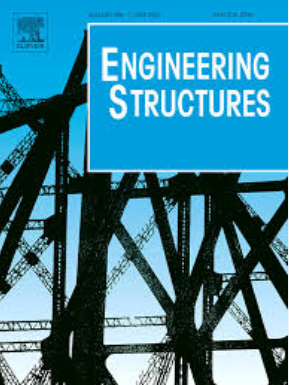冷弯型钢唇形通道高温压缩局部屈曲试验
IF 5.6
1区 工程技术
Q1 ENGINEERING, CIVIL
引用次数: 0
摘要
冷弯型钢构件广泛应用于建筑中,因此了解其在火灾下的行为是十分必要的。虽然在环境温度下的广泛研究导致了冷弯型钢承载系统的设计方法的使用,但对高温对这些薄壁构件屈曲行为的影响仍然缺乏了解,这阻碍了火灾设计方法的发展。本研究提出了一系列稳态试验,以评估短冷弯型钢唇形通道在均匀高温下的强度和稳定性。设计了一种基于可定制炉架和电陶瓷加热垫的新型实验平台进行实验,具有高重复性和对钢温度分布的精确控制。对材料的高温性能进行了试验,并与标准规定进行了比较。唇形通道表现出腹板局部屈曲,部分试件还表现出扭曲屈曲。在300°C时,通道的强度保持了88 %,而在600°C时仅保持了34 %。用壳有限元分析和直接强度法进行强度评估的结果较为保守。本研究促进了对局部屈曲行为的理解,为开发基于性能的冷弯型钢框架结构防火设计方法提供了依据。本文章由计算机程序翻译,如有差异,请以英文原文为准。
Experiments on local buckling of cold-formed steel lipped channels in compression at elevated temperatures
Cold-formed steel members are widely used in buildings, making it essential to understand their behavior under fire. While extensive research at ambient temperature has led to design methods advancing the use of cold-formed steel load bearing systems, there is still a lack of understanding on the effects of elevated temperatures on the buckling behavior of these thin-walled members, which has hindered the development of fire design methods. This study presents a series of steady-state tests to evaluate the strength and stability of short cold-formed steel lipped channels in compression at uniform elevated temperatures. A novel test rig based on a customizable furnace frame and electrical ceramic heating pads was designed to conduct the experiments, showing high repeatability and accurate control of the steel temperature distribution. Coupon tests were conducted to obtain the elevated temperature material properties, which were compared with provisions in standards. The lipped channels exhibited local buckling of the web, with some specimens also displaying distortional buckling. The channels retained about 88 % of their strength at 300°C but only 34 % at 600°C. Strength evaluations with shell finite element analysis and with the Direct Strength Method led to conservative predictions. This study advances understanding of local buckling behavior for development of performance-based structural fire design methods for cold-formed steel-framed structures.
求助全文
通过发布文献求助,成功后即可免费获取论文全文。
去求助
来源期刊

Engineering Structures
工程技术-工程:土木
CiteScore
10.20
自引率
14.50%
发文量
1385
审稿时长
67 days
期刊介绍:
Engineering Structures provides a forum for a broad blend of scientific and technical papers to reflect the evolving needs of the structural engineering and structural mechanics communities. Particularly welcome are contributions dealing with applications of structural engineering and mechanics principles in all areas of technology. The journal aspires to a broad and integrated coverage of the effects of dynamic loadings and of the modelling techniques whereby the structural response to these loadings may be computed.
The scope of Engineering Structures encompasses, but is not restricted to, the following areas: infrastructure engineering; earthquake engineering; structure-fluid-soil interaction; wind engineering; fire engineering; blast engineering; structural reliability/stability; life assessment/integrity; structural health monitoring; multi-hazard engineering; structural dynamics; optimization; expert systems; experimental modelling; performance-based design; multiscale analysis; value engineering.
Topics of interest include: tall buildings; innovative structures; environmentally responsive structures; bridges; stadiums; commercial and public buildings; transmission towers; television and telecommunication masts; foldable structures; cooling towers; plates and shells; suspension structures; protective structures; smart structures; nuclear reactors; dams; pressure vessels; pipelines; tunnels.
Engineering Structures also publishes review articles, short communications and discussions, book reviews, and a diary on international events related to any aspect of structural engineering.
 求助内容:
求助内容: 应助结果提醒方式:
应助结果提醒方式:


